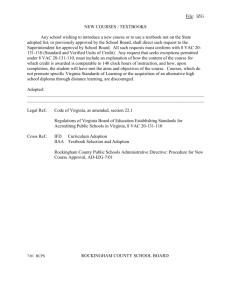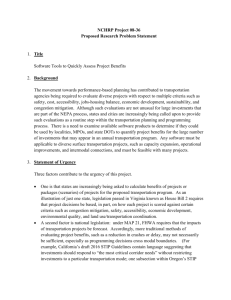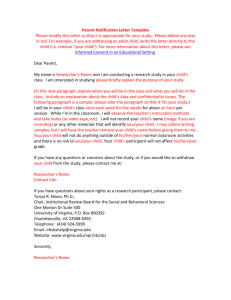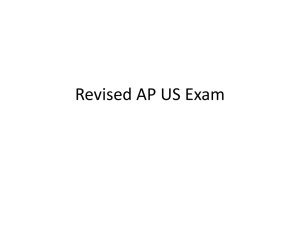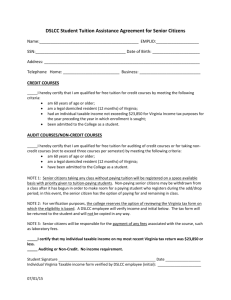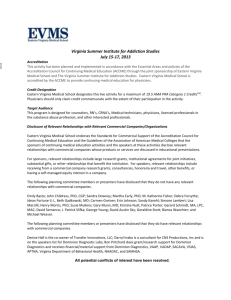Historical Interpretation - UC Berkeley History
advertisement
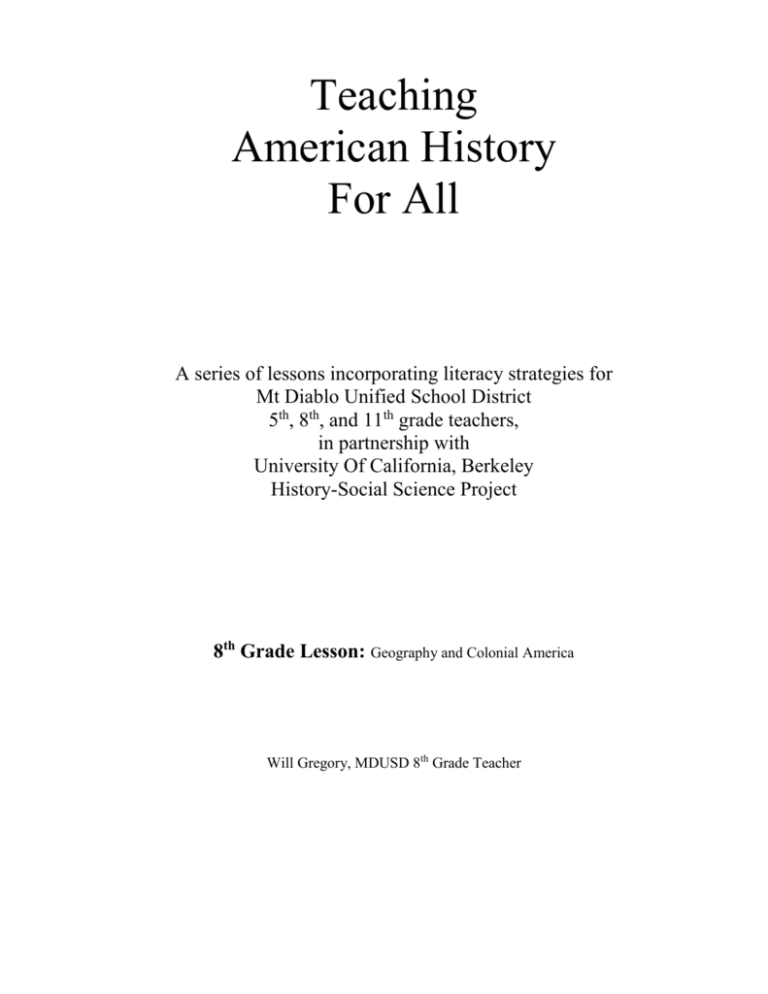
Teaching American History For All A series of lessons incorporating literacy strategies for Mt Diablo Unified School District 5th, 8th, and 11th grade teachers, in partnership with University Of California, Berkeley History-Social Science Project 8th Grade Lesson: Geography and Colonial America Will Gregory, MDUSD 8th Grade Teacher Teaching American History for All MDUSD/UCB H-SSP 8th Grade Lesson: “Geography & Colonial America” Developed by: Will Gregory Teaching American History Grant Focus Question: How have the words and deeds of people and institutions shaped democracy in the U.S.? 8th Grade Year-long Focus Questions: How did federalism shape the roles of the national and state governments? How did the rights of citizens expand and contract during the 18th and 19th centuries? Unit Focus: Examining Colonial America through a geographical perspective, among others. Unit Focus Question: How did the Colonies in America differ geographically, economically, and socially? Unit Working Thesis: The colonies varied in geography, economy, and government from each other, which led to vital regional differences in the U.S. Lesson Focus Question: How was the geography of Colonial America described by early settlers? Lesson Working Thesis: Early colonial settlers stressed the natural resources of America and proclaimed its abundance in relation to Europe. Reading & Writing Strategies: Sentence Level Deconstruction EAR analysis Analytical Paragraph Lesson Assessment Map Activity Suggested Amount of Time: Approximately 90 minutes Textbook: Deverell, William and White, Deborah Gray. United States History: Independence to 1914. Orlando, Florida: Holt, Rinehart and Winston., 2006, Chapter 2: (The English Colonies) p.36-48. Primary Source Citations: Brereton, John, “Briefe and True Relation of the Discoverie of the North Part of Virginia, 1602,” in Burrage, Early Voyages p. 331. Higginson, Francis New Englands Plantation (1630), Massachusetts Historical Society Proceedings, 62 (1929) p. 311; 313-314. "Indians Fishing," watercolor drawing by John White, British Museum (1585-1586). “Their manner of fishynge in Virginia,” engraving by De Bry, John Carter Brown Library at Brown University (1590). Smith, John, A Map of Virginia: With a Description of the Countrey, the Commodities, People, Government and Religion (1612), Wisconsin Historical Society’s Digital Library and Archives, AJ-075 (2003) pp. 80-81. Secondary Source Citation: Changes in the Land: Indians, Colonists, and the Ecology of New England. Cronon, William. New York: Hill and Wang, 1983. Context of the lesson in the unit: This lesson is designed to be one of the first lessons for studying Colonial America. It might be useful to review some of the 7th grade standards on the Age of Exploration beforehand. A brief review of some basic geography skills and vocabulary (such as compass directions) is recommended. West Coast students may need to spend more time familiarizing themselves with East Coast geographic features, such as Chesapeake Bay, the Great Lakes, the Appalachian Mountains, etc. Lesson Procedure: 1. Physical Map activity a. Pass out outline physical map of the Eastern North America b. Have the students open their books to the physical map of the United States (R4 in Atlas) i. Have students circle compass rose ii. Have students underline title iii. Have students label in PENCIL or BLACK Pen: 1. The Atlantic Ocean 2. Chesapeake Bay 3. Cape Cod 4. St. Lawrence River 5. Hudson River 6. Delaware River 7. Ohio river 8. James River 9. Lake Erie iv. v. vi. vii. 10. Lake Ontario 11. Lake Huron 12. Appalachian Mountains Have students use a BLUE colored pencil to color the lakes and rivers listed above. Have students mark the Appalachian Mountains with “^^” symbols. Have students create a color-coded key to label where the following European powers set up colonies. Seep p. 26 in text for reference. 1. France (St. Lawrence River, Great Lakes, Ohio River) 2. England (Massachusetts Bay, James River) 3. The Netherlands (Hudson River) 4. Sweden (Delaware River) 5. Spain (Florida) Pass out sheet protectors and markers for writing on transparencies 1. Have the students put the sheet protectors on the maps. 2. Have the students look at p. 53 and 55 in the text. 3. Have the students create a color-coded key for the New England, Middle and Southern Colonies. Then have the students color those areas on the page protector. 2. Sentence Deconstruction a. Pass out sentence deconstruction sheet & Primary Source handout b. Have students read part of Captain John Smith’s description of Virginia c. Help students to fill out sentence deconstruction activity based on the first paragraph d. Let them finish activity and answer questions alone or with partner e. Review answers as a class 3. EAR Analyzing Evidence a. Now have the students look at the Analyzing Evidence worksheet i. Review the focus question and thesis statement. ii. Explain to the students that we need to find evidence from the primary sources to back up the teaching thesis. iii. Model the evidence from John Smith’s account and come up with what the quotes mean and how they relate to the thesis. iv. Have them work with a partner to finish the handout. v. Discuss as a class to review worksheet, while also emphasizing difference between NE and Chesapeake 4. Structured Paragraph Outline a. Finally, pass out the structured paragraph outline i. Review the writing prompt / focus question ii. Explain what a thesis statement is, and give the students the sample thesis. iii. With the students, show them how to take their evidence from the EAR analysis worksheet and put it into their paragraph outline iv. Include quotes as specific evidence v. Restate their thesis for their conclusion b. Have the students rewrite or type up a final paragraph 5. Extension Activity a. Present the watercolors and engravings from White, and DeBry respectively b. Have the students discuss what they see? i. What might these images mean? c. Compare these sources with the written sources History-Social Science Content Standards: 8.1 Students understand the major events preceding the founding of the nation and relate their significance to the development of American constitutional democracy Historical and Social Sciences Analysis Skills: Chronological and Spatial Thinking 3. Students use a variety of maps and documents to identify physical and cultural features of neighborhoods, cities, states, and countries and to explain the historical migration of people, expansion and disintegration of empires, and the growth of economic systems. Research, Evidence, and Point of View 4. Students assess the credibility of primary and secondary sources and draw sound conclusions from them. 6. Students detect the different historical points of view on historical events and determine the context in which the historical statements were made (the questions asked, sources used, author's perspectives). Historical Interpretation 1. Students explain the central issues and problems from the past, placing people and events in a matrix of time and place. 2. Students understand and distinguish cause, effect, sequence, and correlation in historical events, including the long-and short-term causal relations. 3. Students recognize that interpretations of history are subject to change as new information is uncovered. Reading/Language Arts Content Standards: 2.0 Reading Comprehension (Focus on Informational Materials) Students read and understand grade-level-appropriate material. They describe and connect the essential ideas, arguments, and perspectives of the text by using their knowledge of text structure, organization, and purpose. 1.0 Writing Strategies 1.3 Support theses or conclusions with analogies, paraphrases, quotations, opinions from authorities, comparisons, and similar devices. 2.0 Writing Applications 2.4b. Present detailed evidence, examples, and reasoning to support arguments, differentiating between facts and opinion. 2.0 Speaking Applications (Genres and Their Characteristics) 2.1b. Reveal the significance of, and the subject's attitude about, the incident, event, or situation. INSERT OUTLINE PHYSICAL MAP OF THE U.S. HERE (Needs to be scanned in) Primary Sources: 1) John Smith, A Map of Virginia: With a Description of the Countrey, the Commodities, People, Government and Religion (1612), Wisconsin Historical Society’s Digital Library and Archives, AJ-075 (2003) pp. 80-81. (1) Virginia is a country in America, (2) that lyeth [lies] betweene the degrees of 34’ and 44’ of the north latitude. (3) The bounds thereof on the East side are the great Ocean. (4) On the South lyeth Florida: (5) on the North nova Francia. (6) As for the West thereof, the limits are unknowne […] The Summer is hot as in Spaine; the winter colde as in Fraunce or England […] The colde is extreame sharpe, but here the proverbe is true that no extreame long continueth [the extreme cold does not last long] There is but one entrance by sea into this country and that is at the mouth of a very goodly Bay, the wideness whereof is neare 18. or 20. miles […] This Bay lieth [lies] North and South in which the water floweth neare [flows almost] 200 miles and hath a channell for 140 miles. 2) Francis Higginson, New Englands Plantation (1630), Massachusetts Historical Society Proceedings, 62 (1929) p. 311; 313-314. The aboundance of Sea-Fish are almost beyond believing, and sure I should scarce have believed it except I had seene it with mine owne eyes […] For Beasts, there are some Beares… Also here are severall sorts of Deere… Also Wolves, Foxes, Beavers, Otters, Martins, great wild Cats, and a great Beast called a Molke [moose] as bigge as an Oxe […] Though it bee here somewhat cold in the winter, yet here we have plenty of Fire to warme us, and that a great deale cheaper then they sel […] in London: nay all Europe is not able to afford so great Fires as New-England. A poor servant here that is to possesse but 50 Acres of land, may afford to give more wood for Timber and Fire as good as the world yields, then many Noble men in England can afford to do. TEACHER KEY Row # Time marker / connector words 1. Lesson Question: How was the geography of Colonial America described by early settlers? Who (subject) Participants Action Who, What, Where words Message (verbs / verb phrases) Questions or conclusions – Virginia is a Country in America What is Virginia? A country betweene the degrees of 34’ and 44’ of the north latitude. Where is Virginia located? b/w 34’ and 44’ N. latitude. i.e. Carolinas to Maine on E. Coast Is that where Virginia is today? Nope, much smaller lyeth 2. [Virginia] that 3. The bounds thereof on the East side are the great Ocean What borders Virginia to the East? Atlantic Why isn’t it named? Same ocean as Europe 4. [The bounds] On the South lyeth Florida: Where is Florida in relation to Virginia? South 5. On the North nova Francia What might “nova” mean? new 6. the West thereof, the limits unknowne Why might that be? Appalachian mountains, haven’t been explored, Natives, etc. As for Are Sentence Deconstruction NAME_______________________ P. ___ Lesson Question: How was the geography of Colonial America described by early settlers? Source: John Smith’s A Map of Virginia: With a Description of the Countrey, the Commodities, People, Government and Religion (1612) Row # Time marker / connector words 1. Who (subject) Participants Action Who, What, Where words Message (verbs / verb phrases) Questions or conclusions – Virginia is What is Virginia? betweene the degrees of 2. ___________________ [Virginia] Where is Virginia located? that lyeth of the north Is that where Virginia is today? ___________________. What borders Virginia to the East? 3. The bounds thereof on the East side are 4. [The bounds] On the South lyeth 5. On the North: 6. the West thereof, the limits Why isn’t it named? Where is Florida in relation to Virginia? What might “nova” mean? As for Why might that be? ANALYZING EVIDENCE – CHART TEACHER KEY Writing Prompt: How was the geography of Colonial America described by early settlers? Thesis: Early colonial settlers stressed the natural resources of America and proclaimed its abundance in relation to Europe. EVIDENCE: ANALYSIS What does this mean? This means that … (explanation of evidence) RELEVANCE How does this support your thesis? This relates to ________ (thesis) because … SOURCE Write down your citation information Virginia Virginia is along the Atlantic Ocean. By locating the colony within the Chesapeake and along the Atlantic, it would be accessible to European ships, while also protected Captain John Smith: A Map of Virginia (1612) Colonies in New England had great natural resources Francis Higginson, New Englands Plantation (1630), “The bounds thereof on the East side are the great Ocean… As for the West thereof, the limits are unknowne” “The colde is extreame sharpe, but here the proverbe is true that no extreame long continueth” The short winter means a longer growing season The colony is located / protected within a good bay. “There is but one entrance by sea into this country and that is at the mouth of a very goodly Bay” New England “aboundance of Sea-Fish are almost beyond believing” “Also here are severall sorts of Deere… Also Wolves, Foxes, Beavers, Otters, Martins, great wild Cats…” “all Europe is not able to afford so great Fires as NewEngland” New England offered great fishing, timber and animal life (natural resources) ANALYZING EVIDENCE – CHART NAME____________________ P._____ Writing Prompt: How was the geography of Colonial America described by early settlers? Thesis: Early colonial settlers stressed the natural resources of America and proclaimed its abundance in relation to Europe. EVIDENCE: What quotes would support the above thesis? Virginia “The bounds thereof on the East side are the great Ocean… As for the West thereof, the limits are unknowne” New England ANALYSIS What does this mean? This means that … (explanation of evidence) RELEVANCE How does this support your thesis? This relates to ________ (thesis) because … SOURCE Write down your citation information Captain John Smith: A Map of Virginia (1612) Francis Higginson, New Englands Plantation (1630), PARAGRAPH OUTLINE NAME______________________ P.____ Writing Prompt: How was the geography of Colonial America described by early settlers? Thesis statement: Early colonial settlers stressed the natural resources of America and proclaimed its abundance in relation to Europe. Evidence: _____________________________________________________________________ _____________________________________________________________________________ _____________________________________________________________________________ Spec. Evidence:________________________________________________________________ _____________________________________________________________________________ _____________________________________________________________________________ Analysis: _____________________________________________________________________ _____________________________________________________________________________ _____________________________________________________________________________ Evidence:_____________________________________________________________________ ______________________________________________________________________________ ______________________________________________________________________________ Spec. Evidence:________________________________________________________________ ______________________________________________________________________________ ______________________________________________________________________________ Analysis: _____________________________________________________________________ ______________________________________________________________________________ _______________________________________________________________________________ Concluding statement: ___________________________________________________________ _______________________________________________________________________________ _______________________________________________________________________________ PARAGRAPH OUTLINE TEACHER KEY Writing Prompt: How was the geography of Colonial America described by early settlers? Thesis statement: Early colonial settlers stressed the natural resources of America and proclaimed its abundance in relation to Europe. Evidence: Captain John Smith emphasized the brief winter in his Map of Virginia from 1612. Spec. Evidence: “The colde is extreame sharpe, but here the proverbe is true that no extreame long continueth.” Analysis: This means that Virginia had a mild winter and a longer growing season, making it easier to farm. Evidence: In New England, the Reverend Francis Higginson stressed the vast natural resources of the area. Spec. Evidence: He writes in 1630, “the aboundance of Sea-Fish […] severall sorts of Deere,” and vast amounts of timber readily available in the area. Analysis: By explaining this, Higginson is showcasing the fact that all one would need to live, is more easily available in the colony compared to England. Concluding statement: Early colonial settlers to North America made sure to emphasize the resources found in their colony to show that Europeans would not only thrive, but that life would be better than in Europe. “Their manner of fishynge in Virginia,” engraving by De Bry, John Carter Brown Library at Brown University (1590). "Indians Fishing," watercolor drawing by John White, British Museum (1585-1586).



